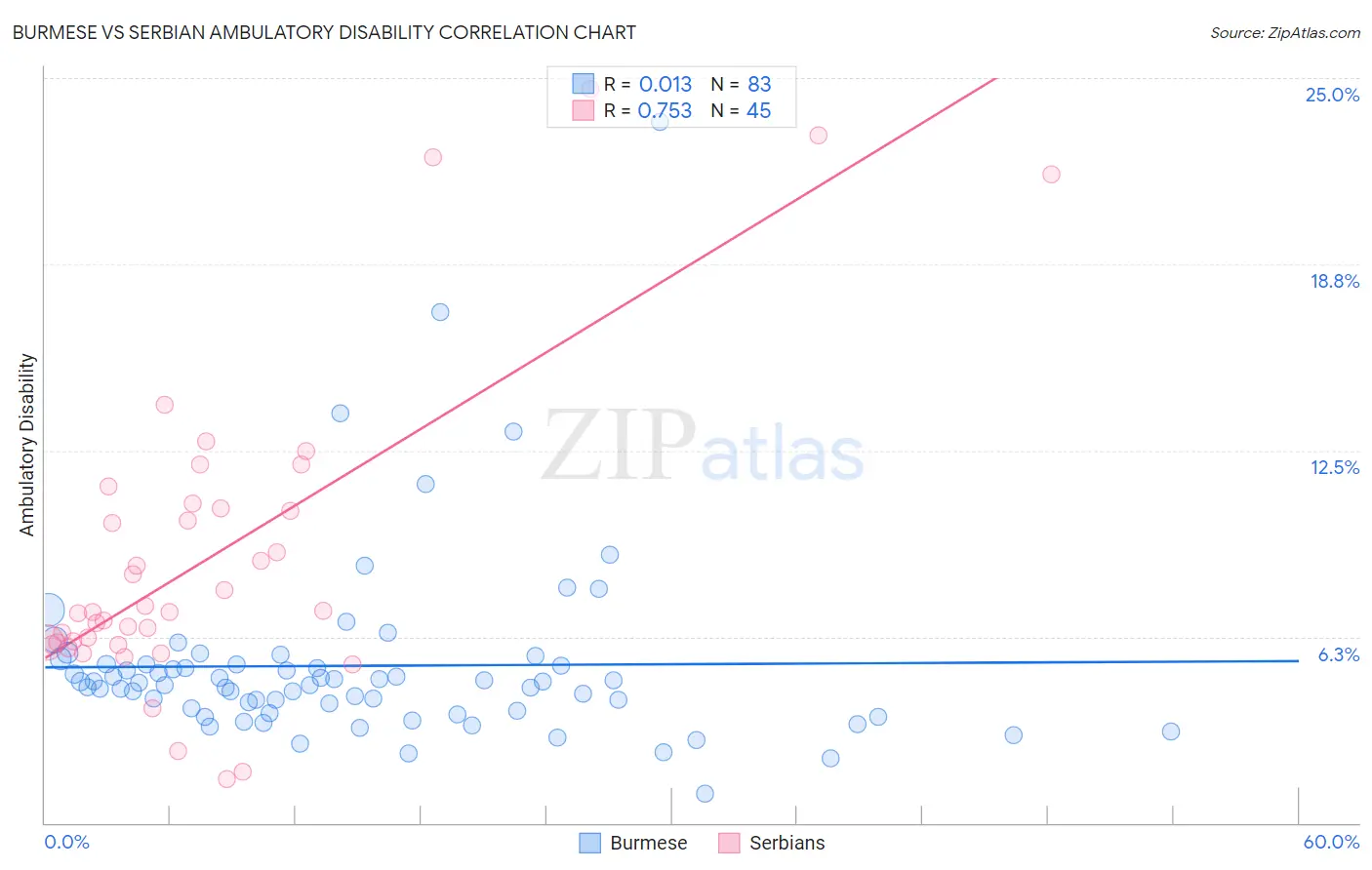Burmese vs Serbian Ambulatory Disability
COMPARE
Burmese
Serbian
Ambulatory Disability
Ambulatory Disability Comparison
Burmese
Serbians
5.3%
AMBULATORY DISABILITY
100.0/ 100
METRIC RATING
13th/ 347
METRIC RANK
6.1%
AMBULATORY DISABILITY
42.8/ 100
METRIC RATING
182nd/ 347
METRIC RANK
Burmese vs Serbian Ambulatory Disability Correlation Chart
The statistical analysis conducted on geographies consisting of 465,101,003 people shows no correlation between the proportion of Burmese and percentage of population with ambulatory disability in the United States with a correlation coefficient (R) of 0.013 and weighted average of 5.3%. Similarly, the statistical analysis conducted on geographies consisting of 267,596,356 people shows a strong positive correlation between the proportion of Serbians and percentage of population with ambulatory disability in the United States with a correlation coefficient (R) of 0.753 and weighted average of 6.1%, a difference of 16.2%.

Ambulatory Disability Correlation Summary
| Measurement | Burmese | Serbian |
| Minimum | 1.0% | 1.5% |
| Maximum | 23.5% | 24.6% |
| Range | 22.5% | 23.2% |
| Mean | 5.3% | 9.0% |
| Median | 4.7% | 7.1% |
| Interquartile 25% (IQ1) | 3.8% | 6.0% |
| Interquartile 75% (IQ3) | 5.3% | 10.6% |
| Interquartile Range (IQR) | 1.5% | 4.6% |
| Standard Deviation (Sample) | 3.2% | 5.2% |
| Standard Deviation (Population) | 3.2% | 5.2% |
Similar Demographics by Ambulatory Disability
Demographics Similar to Burmese by Ambulatory Disability
In terms of ambulatory disability, the demographic groups most similar to Burmese are Immigrants from Eastern Asia (5.3%, a difference of 0.15%), Immigrants from China (5.3%, a difference of 0.48%), Okinawan (5.3%, a difference of 0.50%), Immigrants from Korea (5.2%, a difference of 0.81%), and Immigrants from Hong Kong (5.3%, a difference of 1.0%).
| Demographics | Rating | Rank | Ambulatory Disability |
| Immigrants | Bolivia | 100.0 /100 | #6 | Exceptional 5.0% |
| Bolivians | 100.0 /100 | #7 | Exceptional 5.1% |
| Immigrants | South Central Asia | 100.0 /100 | #8 | Exceptional 5.1% |
| Iranians | 100.0 /100 | #9 | Exceptional 5.1% |
| Yup'ik | 100.0 /100 | #10 | Exceptional 5.2% |
| Immigrants | Korea | 100.0 /100 | #11 | Exceptional 5.2% |
| Okinawans | 100.0 /100 | #12 | Exceptional 5.3% |
| Burmese | 100.0 /100 | #13 | Exceptional 5.3% |
| Immigrants | Eastern Asia | 100.0 /100 | #14 | Exceptional 5.3% |
| Immigrants | China | 100.0 /100 | #15 | Exceptional 5.3% |
| Immigrants | Hong Kong | 100.0 /100 | #16 | Exceptional 5.3% |
| Immigrants | Ethiopia | 100.0 /100 | #17 | Exceptional 5.4% |
| Immigrants | Sri Lanka | 100.0 /100 | #18 | Exceptional 5.4% |
| Indians (Asian) | 100.0 /100 | #19 | Exceptional 5.4% |
| Ethiopians | 100.0 /100 | #20 | Exceptional 5.4% |
Demographics Similar to Serbians by Ambulatory Disability
In terms of ambulatory disability, the demographic groups most similar to Serbians are Swiss (6.1%, a difference of 0.010%), Immigrants from Thailand (6.1%, a difference of 0.030%), Immigrants from Nicaragua (6.1%, a difference of 0.060%), Austrian (6.1%, a difference of 0.070%), and Scandinavian (6.1%, a difference of 0.090%).
| Demographics | Rating | Rank | Ambulatory Disability |
| Vietnamese | 47.2 /100 | #175 | Average 6.1% |
| Immigrants | North America | 45.6 /100 | #176 | Average 6.1% |
| Immigrants | England | 45.4 /100 | #177 | Average 6.1% |
| Scandinavians | 44.5 /100 | #178 | Average 6.1% |
| Austrians | 44.1 /100 | #179 | Average 6.1% |
| Immigrants | Nicaragua | 43.9 /100 | #180 | Average 6.1% |
| Swiss | 43.1 /100 | #181 | Average 6.1% |
| Serbians | 42.8 /100 | #182 | Average 6.1% |
| Immigrants | Thailand | 42.2 /100 | #183 | Average 6.1% |
| Immigrants | Ghana | 41.2 /100 | #184 | Average 6.1% |
| Immigrants | Bosnia and Herzegovina | 37.2 /100 | #185 | Fair 6.2% |
| Europeans | 36.2 /100 | #186 | Fair 6.2% |
| Carpatho Rusyns | 35.3 /100 | #187 | Fair 6.2% |
| British | 34.3 /100 | #188 | Fair 6.2% |
| Ukrainians | 34.0 /100 | #189 | Fair 6.2% |